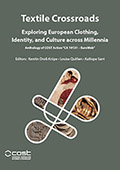Center, Textile Research

Textile Crossroads: Exploring European Clothing, Identity, and Culture across Millennia
Date of this Version
2024
Document Type
Article
Citation
In Textile Crossroads: Exploring European Clothing, Identity, and Culture across Millennia. Anthology of COST Action “CA 19131 – EuroWeb”. Kerstin Droß-Krüpe, Louise Quillien, & Kalliope Sarri, Editors. Zea Books, Lincoln, Nebraska, 2024. DOI: 10.32873/unl.dc.zea.1816
Abstract
People dress for more than just aesthetic reasons. Over the centuries, dress became a sign of human civilization, allowing us to identify the origin, gender, and status of the wearer. Textiles and clothing influence our body, posture, movements, and the way we are perceived by society. Textiles are also a tool used by people to further their agenda, that is why they found their place in the political life of many ancient and modern societies.
According to Michel Foucault, power can be understood as a set of activities influencing the life of the other: It provokes, forbids, or permits, but it can also facilitate or hinder the actions of its subjects. We understand policy as a game that subjects play to gain and sustain their power.
Dress is a material visualization of rules, laws, social order, and identity. It determines and protects the power status of the wearer. Thus, dress is a political statement. The idea that textiles and politics intertwine has long been an accepted fact. However, the idea that ‘political’ textiles and dress might have specific similar traits across time and place, became a pressing question during the conference on Clothing Identities organised by Working Group 2 of the EuroWeb Cost Action (“Clothing Identities Conference”, 6–8 May 2022, online, organized by Magdalena Wozniak, Cecilie Brøns, and Paula Nabais). In this chapter, we aim to examine the question of the relationship between clothing and political life, and whether there are any common traits that make certain textiles or forms of dress a power marker.
For this purpose, two different states have been chosen as case studies: Rome in the time of the Republic and Early Empire, and Medieval Iceland. The first was vast and expansive, the second rather small and isolated. Despite the time difference, they both represent a preindustrial level of development. In both cultures, textiles and dress were significant symbols of status and wealth, as certified by well-known historical treatises and law codes.
Included in
Ancient History, Greek and Roman through Late Antiquity Commons, Archaeological Anthropology Commons, Classical Archaeology and Art History Commons, Classical Literature and Philology Commons, Eastern European Studies Commons, European History Commons, European Languages and Societies Commons, Fiber, Textile, and Weaving Arts Commons, History of Science, Technology, and Medicine Commons, Human Geography Commons, Museum Studies Commons, Place and Environment Commons, Social and Cultural Anthropology Commons, Women's Studies Commons


Comments
Copyright © 2024 by the authors.